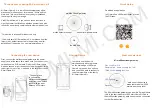
Application Notes
DN530
28
Operator Manual
If the gate is being used creatively, the effect of the gate opening transition can be
accentuated. This is particularly useful on drums, improving definition and punch.
The accent effect is totally independent of the range control, so it is possible to reduce
the range very low or even off (0dB) and still achieve a noticeable enhancement of
transients.
Some benefits of transient accentuation are:
•
Increased tonal shaping effectiveness
Gates can be used to modify the leading
edge of percussive sounds to add definition and punch. This effect can be massively
increased by accenting if required.
•
Reduction of gated breathing
The noise enhancement issues associated with
gating background noise can be reduced or totally eliminated, while retaining the
tonal shaping and punch that a gate can add to percussive sounds.
•
Reduction of delay
When gates are used to reshape the transient start of a sound
they remove a small amount of sound at the start. This effectively causes a slight
delay. Digital gates can capture this sound by using look-ahead techniques, but they
are not time machines; the way they work is to delay the signal until the gate has
opened. This eliminates any losses from the transient, but delays the signal even
further. Using transient accentuation with the gate range at minimum (0dB) ensures
that absolutely no sound is lost and no delay is introduced. However, controlled
accentuation of the transient is still possible.
•
Reduction of resonant howl-round
With high amplification levels it is possible
for a drum to resonate in sympathy with the amplified version of itself similar to
microphonic howl-round. It is possible for this sound to be so loud that once open a
gate will not shut again. If the sound levels are reduced and the drum transients are
accentuated the possibility of howl-round is substantially reduced. The transient
accentuation only lasts for 50ms, so any risk of resonant build up is restricted to this
time period only.
The transient accentuation feature of the DN530 adds another tool for the sound
engineer that can be used to enhance and compliment the application of gating to many
types of sound source.
Music PA
The more mics there are in a public address (PA) system, the more background noise
and stage clutter will be picked up and amplified unless noise gating is used. The most
significant improvement in clarity will be obtained by gating those mics that are used
least often. For example, the mic used only occasionally by a backing vocalist.
Mics used at a fairly high gain setting, such as on a string section, will pick up a lot of
background noise. To improve PA clarity these should also be gated.
Noise gates on the drum mics will also improve the sound of the kit.
Conference PA
In a conference or business presentation PA system there may be several mics in use
simultaneously. Since each mic is placed at some distance from the speaker's mouth,
the gain setting on the console will be quite high. Background noise, such as outside
traffic or air conditioning, will be picked up and amplified, causing a considerable
reduction in the signal to noise ratio of the system. The solution is to gate each mic
individually using the DN530.
Summary of Contents for DN530
Page 2: ......
Page 6: ......
Page 10: ...Precautions DN530 x Operator Manual...
Page 16: ...Chapter 1 Introduction DN530 4 Operator Manual...
Page 20: ...Chapter 2 What Is A Gate DN530 8 Operator Manual...
Page 44: ...Application Notes DN530 32 Operator Manual...
Page 50: ...Balanced Unbalanced Audio DN530 38 Operator Manual...















































